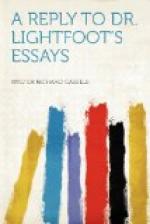Whatever definition be given of miracles, such exceptional phenomena must at least be antecedently incredible. In the absence of absolute knowledge, human belief must be guided by the balance of evidence, and it is obvious that the evidence for the uniformity of the order of nature, which is derived from universal experience, must be enormously greater than can be the testimony for any alleged exception to it. On the other hand, universal experience prepares us to consider mistakes of the senses, imperfect observation and erroneous inference as not only possible, but eminently probable on the part of the witnesses of phenomena, even when they are perfectly honest and truthful, and more especially so when such disturbing causes as religious excitement and superstition are present. When the report of the original witnesses only reaches us indirectly and through the medium of tradition, the probability of error is further increased. Thus the allegation of miracles is discredited, both positively by the invariability of the order of nature, and negatively by the fallibility of human observation and testimony. The history of miraculous pretension in the world and the circumstances attending the special exhibition of it which we are examining suggest natural explanations of the reported facts which wholly remove them from the region of the supernatural.
When we proceed to examine the direct witnesses for the Christian miracles, we do not discover any exceptional circumstances neutralising the preceding considerations. On the contrary, we find that the case turns not upon miracles substantially before us, but upon the mere narratives of miracles said to have occurred over eighteen hundred years ago. It is obvious that, for such narratives to possess any real force and validity, it is essential that their character and authorship should be placed beyond all doubt. They must proceed from eye-witnesses capable of estimating aright the nature of the phenomena. Our four Gospels, however, are strictly anonymous works. The superscriptions which now distinguish them are undeniably of later origin than the works themselves and do not proceed from the composers of the Gospels. Of the writers to whom these narratives are traditionally ascribed only two are even said to have been apostles, the alleged authors of the second and third Synoptics neither having been personal followers of Jesus nor eye-witnesses of the events they describe. Under these circumstances, we are wholly dependent upon external evidence for information regarding the authorship and trustworthiness of the four canonical Gospels.




